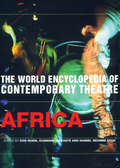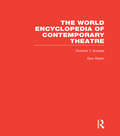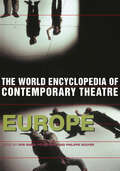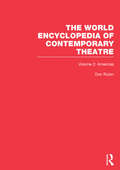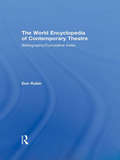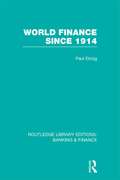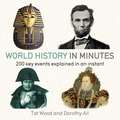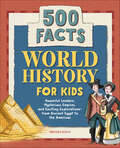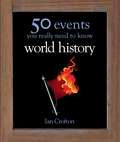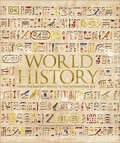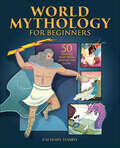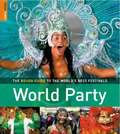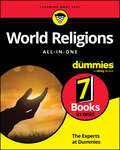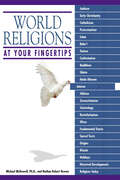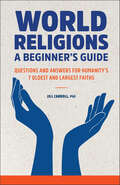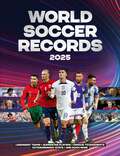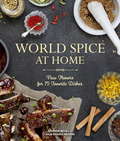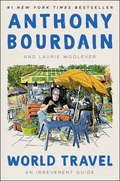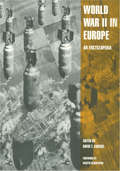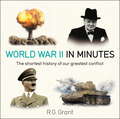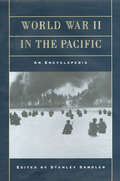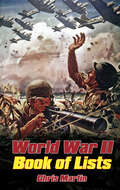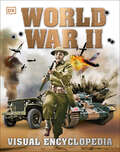- Table View
- List View
World Encyclopedia of Contemporary Theatre: Africa (World Encyclopedia Of Contemporary Theatre Ser.)
by Don Rubin Hansel Ndumbe Eyoh Ousmane DiakhatNow available in paperback for the first time this edition of the World Encyclopedia of Contemporary Theatre series examines theatrical developments in Africa since 1945. Entries on thirty-two African countries are featured in this volume, preceded by specialist introductory essays on Anglophone Africa, Francophone Africa, History and Culture, Cosmology, Music, Dance, Theatre for Young Audiences and Puppetry. There are also special introductory general essays on African theatre written by Nobel Prize Laureate Wole Soyinka and the outstanding Congolese playwright, Sony Labou Tansi, before his untimely death in 1995. More up-to-date and more wide-ranging than any other publication, this is undoubtedly a major ground-breaking survey of contemporary African theatre.
World Encyclopedia of Contemporary Theatre: Volume 1: Europe (World Encyclopedia Of Contemporary Theatre Ser. #Vol. 3)
by Don RubinThe World Encyclopedia of Contemporary Theatre:Europe covers theatre since World War II in forty-seven European nations, including the nations which re-emerged following the break-up of the former USSR, Czechoslovakia and Yugoslavia. Each national article is divided into twelve sections - History, Structure of the National Theatre Community, Artistic Profile, Music Theatre, Theatre for Young Audiences, Puppet Theatre, Design, Theatre, Space and Architecture, Training, Criticism, Scholarship and Publishing and Further Reading - allowing the reader to use the book as a source for both area and subject studies.
World Encyclopedia of Contemporary Theatre: Volume 1: Europe (World Encyclopedia Of Contemporary Theatre Ser.)
by Don Rubin Péter Nagy Philippe RouyerThis new paperback edition of the The World Encyclopedia of Contemporary Theatre: Europe covers theatre since World War II in forty-seven European nations, including the nations which re-emerged following the break-up of the former USSR, Czechoslovakia and Yugoslavia. Each national article is divided into twelve sections - History, Structure of the National Theatre Community, Artistic profile, Music Theatre, Theatre for Young Audiences, Puppet Theatre, Design, Theatre, Space and Architecture, Training, Criticism, Scholarship and Publishing and Further Reading - allowing the reader to use the book as a source for both area and subject studies.A new preface and further reading sections by the Series Editor brings the Encyclopedia bang up-to-date making it invaluable to anyone interested in European theatre, as well as students and scholars of performance studies, history, anthropology and cultural studies.
World Encyclopedia of Contemporary Theatre: Volume 2: The Americas (World Encyclopedia Of Contemporary Theatre Ser.)
by Don Rubin Carlos SolThe second volume of the World Encyclopedia of Contemporary Theatre covers the Americas, from Canada to Argentina, including the United States. Entries on twenty-six countries are preceded by specialist introductions on Theatre in Post-Colonial Latin America, Theatres of North America, Puppet Theatre, Theatre for Young Audiences, Music Theatre and Dance Theatre.The essays follow the series format, allowing for cross-referring across subjects, both within the volume and between volumes.Each country entry is written by specialists in the particular country and the volume has its own teams of regional editors, overseen by the main editorial team based at the University of York in Canada headed by Don Rubin.Each entry covers all aspects of theatre genres, practitioners, writers, critics and styles, with bibliographies, over 200 black & white photographs and a substantial index. This is a unique volume in its own right; in conjunction with the other volumes in this series it forms a reference resource of unparalleled value.
World Encyclopedia of Contemporary Theatre: Volume 6: Bibliography and Cumulative Index (World Encyclopedia Of Contemporary Theatre Ser.)
by Don RubinAn annotated world theatre bibliography documenting significant theatre materials published world wide since 1945, plus an index to key names throughout the six volumes of the series.
World Finance Since 1914 (Routledge Library Editions: Banking & Finance)
by Paul EinzigCharting developments in one of the most turbulent periods of economic history, this far reaching volume covers the problems facing the major economies of Europe in the inter-war years. It also discusses global economic policies and the crises for the world’s major currencies. Although it covers complex themes, the book is written in an accessible way even for the non-specialist.
World Geography: Building a Global Perspective
by Celeste Fraser Thomas J. BaerwaldThis program will help you learn content, develop skills, and apply what you know. Examine these pages to understand how this textbook and its online resources can guide you through the study of world geography.
World History In Minutes
by Tat Wood Dorothy AliWhat happened to the Roman Empire? Why was the Magna Carter so important? What led to the First World War? Why did the USSR collapse? World History in Minutes provides succinct answers to these questions--and many more--in 200 simple and accessible essays.From the 100 Years War to the Gulf Wars, and from the wisdom of Aristotle to the Civil Rights movement, this book distills the major events in human history into easily digestible chunks. Each essay is accompanied by an image--or a clear diagram to illustrate complex ideas--and will plug the gaps in your knowledge of the most important eras, movements and events in the history of humankind. World History in Minutes is the perfect introduction to this expansive subject.Contents include: Neanderthals, Babylonians, Attilla the Hun, Abyssinian Empire, Magna Carta, Black Death, Inca, Henry VIII Reformation, Ulster Plantations, Rousseau and the Enlightenment, Declaration of Independence, French Revolution, Tonga Civil War, Universal Suffrage, Spanish Influenza, Great Depression, Pearl Harbour, The Space Age, Civil Rights, Environmentalism, Oligarchs and Tiger Economies.
World History for Kids: Powerful Leaders, Mysterious Empires, and Exciting Explorations—from Ancient Egypt to the Americas (500 Facts)
by Brooke KhanIncredible world history facts for curious kids ages 8 to 12Kids don't need long, boring textbooks to learn about history! Starting in 4000 BCE and finishing in the modern day, World History for Kids helps them explore the past through interesting and memorable facts that they can share with their friends and family.Help kids discover the story of the world with:500 facts—This book teaches kids about many of the incredible things that have happened over the course of history, one informative tidbit at a time.A world of info—Kids will learn about people and places from all over the globe as this book takes them from ancient Mesopotamia to 20th century America.Middle school essentials—This top choice in history books for kids provides a head start on the topics they'll cover in class, plus things they might not learn in school.Bring history to life with the fascinating facts inside World History for Kids.
World History: 50 Key Milestones You Really Need to Know
by Ian CroftonPeople often complain that in history lessons at school they were taught just a few topics--the Romans, the Tudors, the Nazis--and how they have no idea at all about what happened in between. To remedy this, World History: 50 Things You Really Need to Know offers brief and stimulating outlines of key developments in the history of the world, from the beginning of agriculture 10,000 years ago to the attack on the Twin Towers on 9/11.Each essay is accompanied by a detailed timeline of dates and events, and the flavor of the period concerned is brought to life by selected contemporary quotations from figures as diverse as Aristotle, Ashoka, Saladin, Christopher Columbus, Martin Luther, Suleiman the Magnificent, Galileo, Voltaire, Thomas Jefferson, Mary Wollstonecraft, Napoleon, Lincoln, Lenin and Winston Churchill. In addition, box features throw light on a range of related topics, from the Nazca Lines to Renaissance man, from Confucianism and the state to Alexander the Great's horse, from Islamic science and the Barbary corsairs to the Enigma code and the atomic bomb.
World History: From the Ancient World to the Information Age (DK Ultimate Guides)
by Philip ParkerTake a trip through the defining moments of our global story and see the thinkers, leaders, ideas, and inventions that have shaped the world. Presented in a beautiful slipcase, World History is an essential guide for anyone who loves history or wants to broaden their knowledge. This accessible book covers over 350 of the world&’s most important turning points, from our earliest human ancestors of prehistory to political events of the modern world. Follow detailed maps showing the continuous movement of humans across the Earth, and examine fascinating paintings illustrating the events and individuals that took them there. Beautiful photography throughout the book will carry you back in time to see the people and places of the stories – along with stunning artifacts from every historical period.From magnificent buildings like the Colosseum to magnificent words like &“I have a dream!&”, this guide brings history&’s most significant events to life for every reader to discover and enjoy.
World Mythology for Beginners: 50 Timeless Tales from Around the Globe
by Zachary HambyLose yourself in the world's most compelling mythsPeople have always created stories to explain and explore the world around them. World Mythology for Beginners introduces you to 50 of the most incredible tales of gods, heroes, and monsters. From common classics to lesser-known tales, these compact and modern retellings are a joy to read. You'll never forget the myths, their meaning, and their place within history.Go beyond other mythology books with:Tales from around the world—Discover myths that cover every corner of the globe, from the Greek classics to the oral traditions of Africa.Stories come to life—Read myths and legends presented with a storyteller's flair that makes it easy to enjoy them time after time.Mythology 101—Contextualize each story with a collection of quick facts about its origin, key figures, and insights into the lessons and legends each myth celebrates.Start your journey into the world of mythology with this engaging introductory guide.
World Party: The Rough Guide to the World's Best Festivals
by Rough GuidesIt's Party Time! - World Party is a detailed guide to the world's best events and festivals. If you've ever thought of partying in Rio, throwing tomatoes in Spain or riding a camel in Pushkar, this guide is for you. Detailed accounts of each major festival and insider tips on how best to enjoy each one. The useful 'festival keys' will help you to find the perfect world festival, from the best music, food and arts festivals to long-established religious celebrations to less ancient raves and fruit-throwing events. The guide comes complete with a festival map and calendar with background details and timings for each event. If you love a party The Rough Guide World Party is for you. Join the party at worldparty.roughguides.com
World Religions All-in-One For Dummies
by The Experts at DummiesLearn about the beliefs, history, and culture of the world's most popular religions World Religions All-In-One For Dummies offers an easy starting point for anyone curious to investigate religious and cultural differences. In terms anyone can understand, this book explains the foundations of major world religions, including Christianity, Judaism, Hinduism, Islam, Buddhism, Mormonism, Catholicism, and Taoism. You can choose the religions you'd like to focus on or read about them all. You'll learn about beliefs and practices specific to each, develop an understanding of how religion affects people's lives, and become a more informed global citizen. Awareness of different religions and how they function in society helps people develop tolerance and respect for others. World religion is also a fascinating topic, and you'll enjoy expanding your mind with this fun Dummies guide. Get an overview of the history, beliefs, and practices of the world's major religions Understand the similarities and differences between different sects of each religion Expand your horizons and go beyond the common misconceptions and myths about religion Gain a better understanding of peers, neighbors, coworkers, and friends of different faiths This comprehensive guide is the perfect companion for those beginning their exploration into faith, or for those just needing a quick reference tool.
World Religions at Your Fingertips (At Your Fingertips)
by Nathan Robert Brown Michael McDowellQuick reference to the major religions of the world. With World Religions at Your Fingertips, readers can quickly learn anything they need to know about Buddhism, Christianity, Hinduism, Islam, Judaism, Mormonism, Shinto, Sikhism, Taoism, and more. From reincarnation to resurrection, the Four Noble Truths to the Ten Commandments, this book covers the gamut of religious concepts and beliefs throughout the world in concise but complete bites that are easy to find and simple to understand. • Allows readers to dip in quickly to get the information they need immediately • Thumb tabs and other navigational aids make this the quintessential reference book on world religion • Content is thorough and even-handed
World Religions: Questions and Answers for Humanity's 7 Oldest and Largest Faiths
by Jill CarrollYour guide to understanding seven of the world's most prominent religionsIf you're interested in learning about world religions, this book is the place to start. Packed with informative fact sheets and answers to common questions, this beginner's guide fills you in on the most important aspects of each religion. You'll learn about fascinating histories, rituals, and festivals as you grow to better understand the belief systems that offer meaning and purpose to billions of people around the globe.This beginner's guide to major world religions features:Seven world religions—Discover the basic tenets and practices of Hinduism, Judaism, Taoism, Buddhism, Christianity, Islam, and Shikhism.Digestible snapshots—Learn key dates, major sects, primary texts, the most recognizable symbols, and everyday practices at a glance.A Q&A format—By presenting facts through questions and answers, this book uses a conversational tone that makes information easier to understand and remember.Build your knowledge of world religions with this beginner's guide.
World Soccer Records 2025
by Keir RadnedgeThe best-selling collection of soccer facts, stats and stories is back for another fully updated edition!World Soccer Records 2025 offers lively, fun and fascinating facts and stats from the world of international soccer. Focusing on all the major world and continental tournaments, national team records, exceptional matches and the stars who made it all possible, this exhaustively researched annual tells the stories of these key moments and the players and coaches behind them.This new edition includes updated stats and facts for all recent major tournaments, awards and international teams. You'll also find the latest record-breaking achievements of more than 35 featured nations from around the world, including a sidebar with key stats, as well as updates and records for most of the other 170+ FIFA members.
World Soccer Records 2025
by Keir RadnedgeThe best-selling collection of soccer facts, stats and stories is back for another fully updated edition!World Soccer Records 2025 offers lively, fun and fascinating facts and stats from the world of international soccer. Focusing on all the major world and continental tournaments, national team records, exceptional matches and the stars who made it all possible, this exhaustively researched annual tells the stories of these key moments and the players and coaches behind them.This new edition includes updated stats and facts for all recent major tournaments, awards and international teams. You'll also find the latest record-breaking achievements of more than 35 featured nations from around the world, including a sidebar with key stats, as well as updates and records for most of the other 170+ FIFA members.
World Spice at Home
by Julie Kramis Hearne Charity Burggraaf Amanda BevillFans of Yotam Ottolenghi's Plenty and Jerusalem will be thrilled with the exciting new spice profiles in these 75 recipes. This book brings the world's exotic spices to your home kitchen to breath new life into favorite, familiar, and traditional dishes with wonderful new flavors. Transform a grilled ribeye steak using an Arabic baharat spice blend; add drama to your carrot cake using Kashmiri garam masala. Spices add gratifying dimension to foods, and while the spice blends come from around the world, these recipes are friendly and familiar.From the Trade Paperback edition.
World Travel: An Irreverent Guide
by Anthony Bourdain Laurie WooleverA guide to some of the world’s most fascinating places, as seen and experienced by writer, television host, and relentlessly curious traveler Anthony BourdainAnthony Bourdain saw more of the world than nearly anyone. His travels took him from the hidden pockets of his hometown of New York to a tribal longhouse in Borneo, from cosmopolitan Buenos Aires, Paris, and Shanghai to Tanzania’s utter beauty and the stunning desert solitude of Oman’s Empty Quarter—and many places beyond.In World Travel, a life of experience is collected into an entertaining, practical, fun and frank travel guide that gives readers an introduction to some of his favorite places—in his own words. Featuring essential advice on how to get there, what to eat, where to stay and, in some cases, what to avoid, World Travel provides essential context that will help readers further appreciate the reasons why Bourdain found a place enchanting and memorable.Supplementing Bourdain’s words are a handful of essays by friends, colleagues, and family that tell even deeper stories about a place, including sardonic accounts of traveling with Bourdain by his brother, Christopher; a guide to Chicago’s best cheap eats by legendary music producer Steve Albini, and more. Additionally, each chapter includes illustrations by Wesley Allsbrook.For veteran travelers, armchair enthusiasts, and those in between, World Travel offers a chance to experience the world like Anthony Bourdain.
World War II in Europe: An Encyclopedia (Military History of the United States)
by David T. Zabecki Carl O. Schuster Paul J. Rose William H. Van HusenFirst Published in 1999. Routledge is an imprint of Taylor & Francis, an informa company.
World War II in Minutes (In Minutes Ser.)
by R. G. GrantClear, concise yet comprehensive, World War II in Minutes is the quickest way to understand the greatest conflict in human history. From its causes to its aftermath, this book details in 200 mini-essays every key event of the war, including the rise of Hitler, the Dunkirk evacuation, The Battle of Britain, Pearl Harbor, Midway and Iwo Jima, the sieges of Leningrad and Stalingrad, the bombings of Hiroshima and Nagasaki, D-Day and the fall of Berlin, and much much more.Covers all aspects of World War II: origins and politics; major battles; great leaders; weapons and technology; civilian life and atrocities; turning points and surrenders; and the reverberations of the war through history. Illustrated with 200 contemporary photographs, images and maps.Includes entries on: The Path to War; The Versailles Treaty; The Spanish Civil War; Mussolini and the rise of Fascism; Adolf Hitler, Winston Churchill, FDR and Joseph Stalin; The Sino-Japanese War; The Blitz; U-boat warfare and Enigma; The Desert War; Operation Barbarossa; The Battle of Moscow; Resistance and collaboration; The Final Solution; Colditz; Coral Sea and Guadalcanal; The Dambusters; The bombing of Dresden; Alamein; Kursk; Montgomery, Zhukov, Rommel and Eisenhower; Operation Overlord; The liberation of Paris; The battle of the Bulge; The Yalta Conference, The Berlin bunker; The battle for Okinawa; Kamikazes; The atomic bomb; Casualties of war; War crimes trials and The Cold War.
World War II in the Pacific: An Encyclopedia (Military History of the United States)
by Sandler StanleyStanley Sandler, one of America's most respected and best-known military historians, has brought together over 300 entries by some 200 specialists in the field to create the first encyclopedia specifically devoted to the Pacific Theatre of World War II.Extending far beyond battles and hardware, the coverage ranges from high policy-making, grand strategy, and the significant persons and battles of the conflict, to the organization of the Allied and Japanese divisions, aircraft, armor, artillery, psychological warfare, warships, and the home fronts, covering the interactions of each topic along the way.
World War II: The Book of Lists
by Chris MartinEverything you ever wanted to know about the Second World War, from the highest-rated fighter aces to the most inventive escape equipment used to break out of Colditz; from army pay by rank to the largest battleships; from the most stirring speeches to the biggest tactical errors; from the strangest regimental mottoes to the plays most performed by ENSA; and from the dates each country joined the war to the most unlikely spies. All the major events and dates in the war are covered in detail, but equal emphasis is placed on the human experience of combat. Often poignant and always revealing, World War II: the Book of Lists offers a unique insight into the deadliest conflict in human history.
World War II: Visual Encyclopedia (DK Children's Visual Encyclopedias)
by DKThis comprehensive visual encyclopedia explores World War II in fascinating detail and explains why this global event must never be forgotten. World War II: Visual Encyclopedia shows children the causes, battles, people, and aftermath, while cutting-edge CGI technology brings infamous events back to life. Learn about weaponry, tanks, ships, aircraft, campaigns, and military strategies. Read firsthand accounts of major campaigns and battles throughout the war. Uncover hundreds of biographies of wartime leaders and brave soldiers who served on the battlefields. Find out how technological advances influenced the final outcome. Key information is available at a glance, alongside data boxes, facts and stats, and inspiring quotations. From the fastest fighter plane to the longest battle, you&’ll discover everything you ever wanted to know, and much, much more.Whether you&’re a history buff or simply want help on a school project, this standout reference covers every aspect of World War II and the important part it has played in world history.
